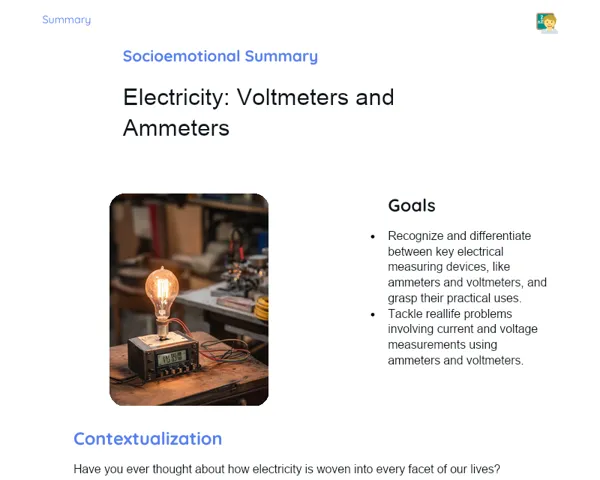Summary Tradisional | Magnetism: Force on Current-Carrying Wire
Contextualization
Magnetism is a fascinating natural phenomenon that pertains to the forces magnets exert on certain materials and on each other. When electric current flows through a wire, it produces a magnetic field around it, creating an interesting interaction between electricity and magnetism. This interaction is crucial for the functioning of various technological devices that we rely on every day, including electric motors, generators, and speakers.
Grasping how magnetic force acts on wires carrying electric current is essential for understanding many foundational principles of physics and engineering. The formula that outlines this force, F = I × L × B × sin(θ), serves as an invaluable starting point for tackling both practical and theoretical challenges. Moreover, the Biot-Savart Law and the Right-Hand Rule are key principles to determine the direction and magnitude of this force, which allows for accurate applications of magnetism concepts in a variety of real-world scenarios.
To Remember!
Magnetic Force on Wires with Electric Current
The magnetic force exerted on a wire carrying electric current arises from the magnetism that the current generates within the wire. The formula that describes this force is F = I × L × B × sin(θ), where F represents the magnetic force, I denotes the electric current, L is the length of the wire, B represents the magnetic field, and θ signifies the angle between the wire and the magnetic field. This equation enables the calculation of magnetic force under various conditions and is fundamental for resolving practical issues related to magnetism.
The elements of the formula directly influence the magnetic force's magnitude. For instance, an increase in electric current (I) or magnetic field (B) results in a greater force. Similarly, the orientation of the wire concerning the magnetic field, signified by the sine of angle (sin(θ)), also plays a role in determining the resulting force. When the wire is perpendicular to the magnetic field, the force reaches its peak, while if it is parallel, the force becomes zero.
This formula's comprehension is essential for analyzing intricate electromagnetic systems, such as electric motors and generators. In these devices, magnetic force is instrumental in converting electrical energy into mechanical motion, or vice versa. Therefore, understanding how to calculate this force is vital for developing and optimizing technologies rooted in magnetism.
-
The magnetic force is influenced by electric current, the wire's length, the magnetic field, and the angle between the wire and the field.
-
The force is maximized when the wire is perpendicular to the magnetic field and becomes zero when parallel.
-
The formula F = I × L × B × sin(θ) is fundamental for addressing practical challenges in electromagnetism.
Biot-Savart Law
The Biot-Savart Law is an important formula that outlines how an electric current produces a magnetic field around a wire. The mathematical representation of this law is B = (μ₀ / 4π) × (I × dl × sin(θ) / r²), where B signifies the magnetic field, μ₀ denotes the permeability of free space, I represents the electric current, dl is an infinitesimal segment of the wire, θ is the angle between the segment dl and the line connecting the segment to the point where the field is measured, and r is the distance from the segment dl to the evaluation point.
This law is pivotal for understanding how the magnetic field varies with distance and orientation concerning the conducting wire. It allows for the calculation of the magnetic field produced at various points in space around a wire conducting electric current. The Biot-Savart Law is particularly useful in scenarios where the magnetic field is not uniform and changes from point to point.
Practical applications of this law include calculating the magnetic field in systems like solenoids and coils, which are critical components in numerous electromagnetic devices. A solid grasp of the Biot-Savart Law enables predictions about how the magnetic field behaves in diverse current configurations and wire shapes, vital for designing and analyzing complex electromagnetic systems.
-
The Biot-Savart Law explains how electric current generates a magnetic field around a wire.
-
The formula B = (μ₀ / 4π) × (I × dl × sin(θ) / r²) is utilized to calculate the magnetic field at any location around the wire.
-
This law is essential for comprehending the variations in magnetic fields within systems such as solenoids and coils.
Right-Hand Rule
The Right-Hand Rule is a practical method for determining the direction of the magnetic force acting on a wire that is conducting electric current. To apply this rule, extend your right thumb in the direction of the electric current, point your fingers in the direction of the magnetic field, and your palm will indicate the direction of the resultant magnetic force. This rule is a straightforward application of the vector product of the current and the magnetic field, defining the magnetic force.
The Right-Hand Rule is tremendously beneficial in situations where visualizing magnetic force orientation is necessary. It facilitates a clearer understanding of how magnetic force interacts with electric current and the magnetic field, allowing for improved and quicker analysis of electromagnetic challenges. This rule finds applicability in various contexts, from analyzing circuits to operating motors and generators.
Grasping and correctly applying the Right-Hand Rule is essential for solving problems related to magnetic force direction. It aids in predicting how electromagnetic devices behave under varying current and magnetic field conditions, contributing to the design and enhancement of technologies reliant on magnetism.
-
The Right-Hand Rule is used to find the magnetic force direction on a wire carrying electric current.
-
The thumb indicates the current's direction, fingers show the magnetic field direction, and the palm reveals the magnetic force.
-
This rule is beneficial for visualizing magnetic forces' orientation in real-world problems.
Solving Practical Problems
Tackling practical problems that involve magnetic force on wires with electric current is a vital capability for students studying physics and engineering. These challenges generally require the use of the formulas and concepts we've discussed earlier, such as the formula F = I × L × B × sin(θ), the Biot-Savart Law, and the Right-Hand Rule. Regular practice in solving these problems reinforces theoretical understanding and develops the skill to apply knowledge in real situations.
For instance, a typical problem might involve calculating the magnetic force on a wire of a specified length, conducting a particular current, and located within a uniform magnetic field. Another problem might call for determining the magnetic field produced by a long, straight wire at a defined point in space. Solving these challenges involves identifying the necessary components, applying the appropriate formulas, and interpreting the results logically.
Being proficient in solving practical problems is essential for analyzing and designing electromagnetic systems, like motors, generators, and transformers. This capability allows for forecasting how these systems react under diverse conditions and optimizing their performance. Thus, continuous practice in problem-solving is a crucial element of learning the concepts around magnetism and electricity.
-
Solving practical problems reinforces theoretical knowledge and builds practical skills.
-
Common problems involve calculating magnetic forces and fields in various scenarios.
-
Problem-solving is pivotal for analyzing and designing electromagnetic systems.
Key Terms
-
Magnetic Force: The force acting on an electric current within a magnetic field.
-
Formula F = I × L × B × sin(θ): A formula for calculating the magnetic force in a wire with electric current.
-
Biot-Savart Law: A law that explains how electric current generates a magnetic field around a wire.
-
Right-Hand Rule: A practical method to determine the direction of the magnetic force acting on a wire with electric current.
-
Electric Current: The flow of electric charge through a conductor.
-
Magnetic Field: The area surrounding a magnet or electric current where magnetic forces can be detected.
Important Conclusions
Studying magnetic force in wires with electric current is paramount for comprehending the mechanics of various technological devices such as motors, generators, and speakers. Applying the formula F = I × L × B × sin(θ) enables the calculation of magnetic force in diverse scenarios, underscoring the significance of components such as electric current, wire length, magnetic field, and the angle between the wire and field. The Biot-Savart Law and the Right-Hand Rule are essential tools for determining both the magnitude and direction of the magnetic force, laying a strong foundation for the analysis and design of electromagnetic systems.
Grasping the Biot-Savart Law is critical for calculating the magnetic field generated by a wire conducting electric current, particularly in systems where the magnetic field is not uniform. This law assists in anticipating how magnetic fields behave under varying current conditions and wire shapes, which is fundamental for advancing technologies reliant on magnetism. The Right-Hand Rule, in this regard, helps visualize the orientation of magnetic forces, serving as a practical and intuitive tool for resolving electromagnetic challenges.
The aptitude for solving practical problems involving magnetic force in wires with electric current reinforces theoretical understanding and nurtures practical abilities, both of which are integral for analyzing and constructing electromagnetic systems. Consistent practice and application of the concepts discussed in this study are crucial for developing the skills needed to tackle real-world challenges in physics and engineering. We encourage students to deepen their understanding of this topic, exploring new applications and technologies that utilize magnetism.
Study Tips
-
Regularly revise the concepts and formulas discussed in class, such as F = I × L × B × sin(θ), the Biot-Savart Law, and the Right-Hand Rule, to solidify your understanding.
-
Practice solving practical problems that involve magnetic force in varied scenarios, using examples from your textbook and looking for additional exercises in books and online resources.
-
Investigate real-world applications of magnetism in modern technologies, like electric motors, generators, and magnetic resonance devices, to get a better grip on the concepts studied and their practical implications.



